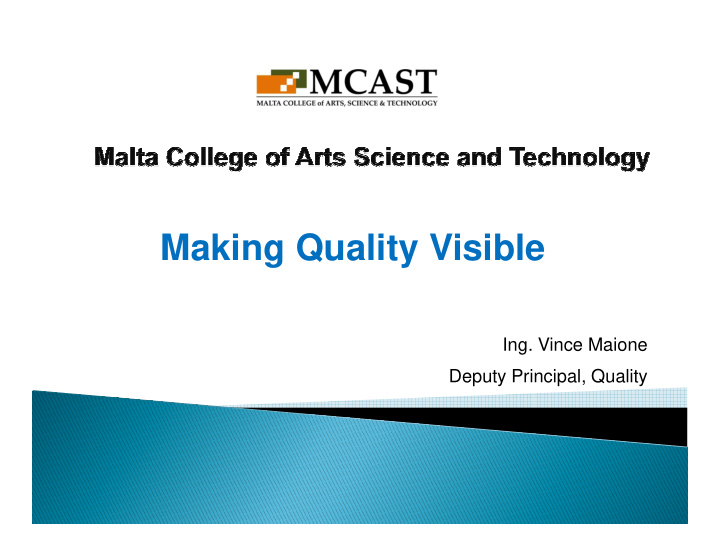



Making Quality Visible Ing. Vince Maione Deputy Principal, Quality
• Mission Statement and Quality Policy • MCAST today • External and Internal Factors • MCAST Quality Management System • Conclusion
Mission Statement To provide universally accessible vocational and professional education and training with an international dimension, responsive to the needs of the individual and the economy.
Quality Policy The College will fulfil its Mission by ensuring that all programmes are designed and validated with the involvement of industry/business in order to ensure that the stakeholders’ expectations are met and even exceeded when these programmes are being delivered. The College aims to achieve this by committing to a structured Quality The College aims to achieve this by committing to a structured Quality Management System that facilitates continuous improvement. MCAST shall subscribe to measurable and realistic objectives through the involvement of learners and trained staff on an on-going basis
• Current number of full-time students 6,000 • Full-time courses offered 170 • Part-time courses offered 300 • Number of institutes 10 • Level of courses MQF Level 1 to MQF Level 6
MCAST Quality Management System: External and Internal Factors COPENHAGEN PROCESS BOLOGNA PROCESS Vocational education Academic education Education as driver for : • Economic growth •Mobility of people Local EQAVET ISO9001 / Standards and EFQM Legislation Manual BV QMS Guidelines (ESG) MCAST Quality Management System MCAST Quality Management System INSTITUTES AWARDING BODIES REGULATORY FRAMEWORK Electrical and Electronics Eng MCAST Home grown courses Business and Commerce BTEC National Commission for Mechanical Engineering City and Guilds Higher Education (NCFHE) Community Services AAT Standards for Training, Applied Science ITEC Certification Art and Design Watch keeping (STCW) Information Technology European Aviation Safety Maritime Agency (EASA) Agribusiness QCF Building & Construction Eng.
MCAST Quality Management System Requirements (ESG EHEA Guidelines + BV Standard + EQAVET Indicators) Audits and Verification Internal Standard External External Audits Verifiers Examiners Audits Measurement, Analysis and Improvement Support Processes Management Control of Operational Processes nonconforming Responsibility Services EXTERNAL CUSTOMER REQUIREMENTS Management of Management of Resources Corrective Action Administration of QMS Environment, Preventive Action facilities and equipment Learner Support Analysis of EQAVET Indicators INTERNAL CUSTOMER SATISFACTION Public Information
MCAST QUALITY MANAGEMENT SYSTEM INPUT OUTPUT QUALITY STANDARDS / GUIDELINES MEASUREMENT MEASUREMENT STANDARDS AND GUIDELINES FOR EQARF QUALITY ISO 9001:2008 : Quality EQARF QUALITY QUALITY ASSURANCE IN THE EUROPEAN INDICATORS Management System INDICATORS HIGHER EDUCATION AREA FOR ASSURING Requirements / BV FOR ASSURING QUALITY Standard for Quality QUALITY monitoring and periodic 1.4 Quality assurance of 1.6 Information systems 1.5 Learning resources review of programmes IN VET 1.7 Public information Management Systems of IN VET and student support 1.3 Assessment of procedures for QA (Maritime) Training 1.1 Policy and 1.2 Approval, Institutes teaching staff and awards. students Investment in training Number of persons of teachers and 1 Management Responsi having completed Y Y trainers trainers VETprogrammes VETprogrammes Participation rate in Placement rate after 2 Administration of QMS Y Y Y Y VET programmes completion of training Mechanisms to Utilisation of acquired 3 Management of Resour Y Y Y identify training needs skills at workplace Development of 4 academic courses Y and programmes Realisation of 5 Y Y Y Y Y educational services Environment, 6 Facilities and Y Equipment Measurement, 7 analysis and Y Y Y Y improvement
� Management commitment � Quality Policy � Relations with stakeholders � Quality Objectives � Quality Planning
� Provision of resources � Training and CPD of staff � Facilities (ICT, Learning Resource Centre, etc) � Working environment
� Responsibility and authority � Management Representative � Quality Manual � Internal communication � Document and data control � Management review � Control of quality records
� Location to perform the activities and the supporting equipment including all utilities. � Supporting services including communication and information systems � Availability of consumables required for the education process � Adequate learning environment
� Measurement and monitoring of Customer satisfaction � Control of non-conforming services � Analysis of data � Corrective action � Preventive action
� Availability of Learner guidance and counselling support systems
� Publication of regular, impartial and objective information abut the programmes, both qualitative and quantitative, about the programmes and awards they are offering
Thank you for your attention.
Recommend
More recommend